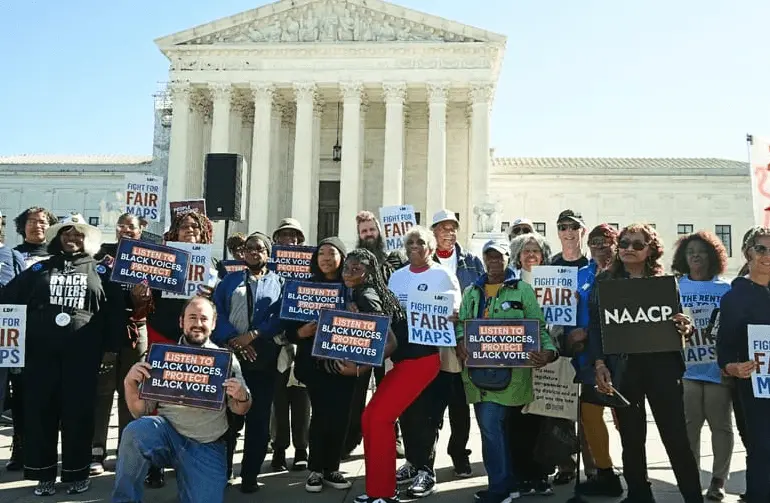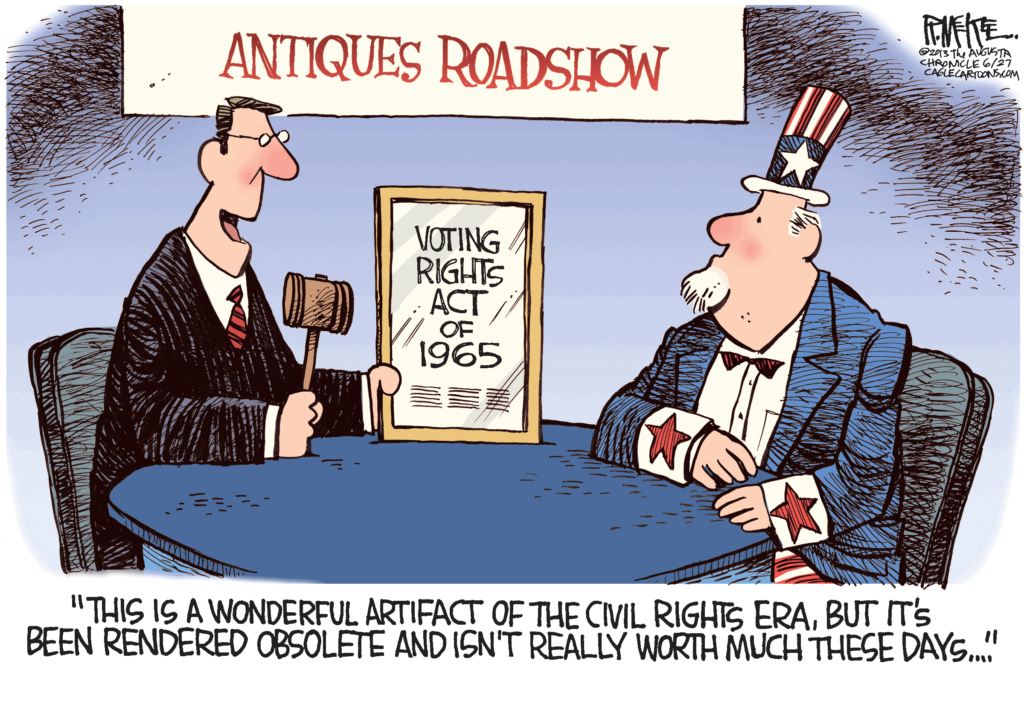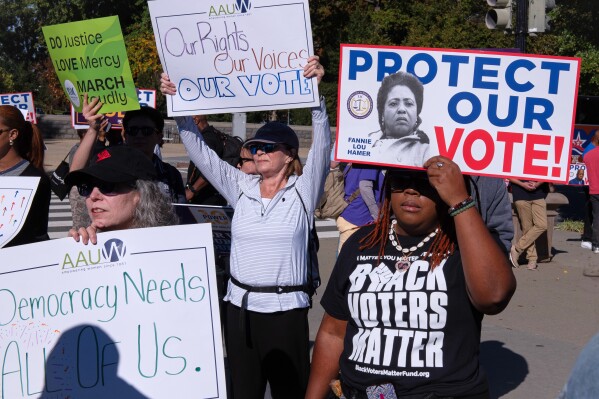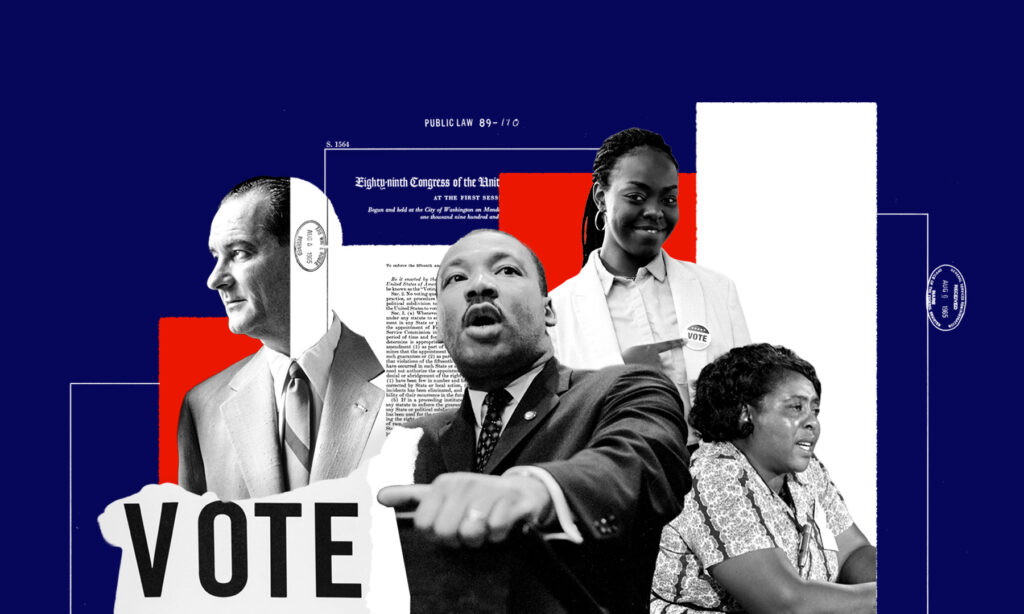
The Voting Rights Act (VRA) of 1965 is one of the most consequential laws in U.S. civil rights history. Enacted to stop racial discrimination in voting, it helped dismantle Jim Crow laws and protected minority voters for decades. But as of 2025, this historic law faces serious challenges. New court cases, shifting interpretations, and political pressures threaten to weaken its key provisions. In this article, we will:
- Trace the origin and major provisions of the Voting Rights Act
- Highlight historic and recent landmark cases that shaped its meaning
- Examine the current challenges it faces in 2025, especially litigation and Supreme Court scrutiny
- Assess the consequences if parts of the VRA are curtailed
- Look ahead: possible reforms, protections, and what citizens and lawmakers can do
This article aims to give readers clear context, legal insight, and a roadmap for understanding how the VRA remains central to U.S. democracy — and why its future matters now more than ever.
1. History & Major Provisions of the Voting Rights Act
Background
After decades of racial discrimination in voting — poll taxes, literacy tests, “grandfather clauses,” and widespread disenfranchisement of Black Americans — Congress passed the Voting Rights Act in 1965. The Act enforced the 15th Amendment’s promise that the right to vote could not be denied because of race, color, or previous condition of servitude. It responded especially to violent resistance in Southern states to African American voting — events like Selma’s Bloody Sunday helped build momentum.
Key Sections of the VRA

Some of the most important parts of the law include:
- Section 2: Prohibits voting practices or procedures that discriminate on the basis of race, color, or membership in a language minority group. This section is nationwide and allows lawsuits against laws that dilute minority voting power or unjustly burden minority voters.
- Section 4(b) and Section 5 (preclearance): Originally, certain states or electoral jurisdictions with histories of discrimination had to get federal approval (preclearance) before making changes to voting laws or district maps. Section 4(b) defined which jurisdictions were covered; Section 5 required preclearance.
- Section 3(c) and Section 6: Dealt with certain enforcement and coverage in specific areas. (Over time, many parts have been modified by courts or by Congress.)
Supreme Court Decisions That Shaped the VRA
- Shelby County v. Holder (2013): The U.S. Supreme Court struck down Section 4(b), which meant the preclearance requirement (Section 5) could no longer be enforced the same way, since there was no coverage formula. This decision significantly weakened preclearance enforcement.
- Brnovich v. Democratic National Committee (2021): The Court narrowed how Section 2 is applied, especially concerning policies like “out-of-precinct” voting and ballot collection. It made it harder for plaintiffs to challenge certain voting restrictions under Section 2. Wikipédia
These rulings, among others, have shaped how the VRA works today. Many of its protections remain in place, but legal interpretations are tighter, and enforcement is more contested.

2. Recent Legal Battles & Supreme Court Cases (2025)
Louisiana v. Callais / Robinson v. Callais
One of the most important current cases involves Louisiana v. Callais (sometimes joined with Robinson v. Callais). This case challenges the way Louisiana redrew its congressional districts after the 2020 Census. Because Black people make up about a third of the population in Louisiana, plaintiffs argued the state should have drawn multiple majority-Black districts. Lower courts found that the original map violated Section 2 of the VRA. Reuters+3American Civil Liberties Union+3Politico+3
However, the state drew a new map with a second majority-Black district; that new map is now being challenged by plaintiffs who argue that the map relies too heavily on race, violating constitutional equal protection under the 14th Amendment. The Supreme Court has heard arguments on whether such race-conscious redistricting is still permissible. If the Court strikes down this kind of map‐drawing or limits Section 2 significantly, the protection against vote dilution could be greatly weakened. AP News+3Reuters+3The Guardian+3
Enforcement via Private Lawsuits & Section 1983
Another major issue is whether individuals and civil rights groups can bring lawsuits under Section 2 or whether they’re limited in doing so by other rulings. A lower federal appeals court (the 8th Circuit) recently held that under Section 1983 (a civil rights statute), private individuals may not sue state or local officials for violations of Section 2. This significantly limits who can enforce the law when government departments don’t act. WJCT News 89.9+1
Other Cases and Trends
- Courts have challenged whether race can be used in map-drawing, especially where the majority-minority district is at issue. Some Justices have argued for a “color-blind” constitutional approach that would limit or invalidate race-based remedies even in contexts of historical discrimination. Reuters+1
- There is also concern over the weakening or removal of other sections, whether by precedent or by new cases. Some states have responded by passing their own state‐level voting rights protections to fill gaps left by federal weakening. Stateline+1

3. What Are the Consequences if Key VRA Protections Are Weakened?
Reduced Protection Against Gerrymandering
If Section 2 is narrowed or limited in its enforcement, mapmakers might redraw districts in ways that dilute minority voting power (packing, cracking) without effective legal challenge. This could reduce representation in Congress and state legislatures for racial and ethnic minorities.
Less Access to Legal Recourse
With restrictions on private lawsuits (such as through Section 1983), enforcement may be left mostly to the Department of Justice or civil rights organizations with fewer resources. Geographic and financial barriers may make it difficult for plaintiffs in many parts of the U.S. to fight discriminatory laws.
Backsliding on Voter Protections
Other protections — access to polling places, language assistance, voting by mail, early voting — may be more vulnerable to restrictive state laws if federal oversight is reduced. State laws in some places already impose strict voter ID, limit ballot drop boxes, or place burdens on vote by mail. Without strong VRA enforcement, those laws may escape challenge.
Political & Social Implications
- Minority voters may face disenfranchisement.
- Political polarization may increase, especially if certain demographic groups feel their voting power is being ignored or diluted.
- Trust in elections and democratic institutions could erode if citizens feel their rights aren’t protected.
4. What Can Be Done? Reforms, Protections & Paths Forward
Legislation & Congress
- Congress could pass a new law to restore or replace the preclearance formulas struck down in Shelby County v. Holder.
- Amend the Voting Rights Act to clarify or strengthen Section 2, including explicitly protecting private suits and defining criteria for when a district must be majority-minority.
- Add or improve federal protections for ballot access, voter ID laws, early voting, mail voting, and language and disability assistance.
State-Level Measures
- Some states are already enacting their own voting rights laws to mirror federal protections. These can plug gaps when federal law is weak.
- Independent redistricting commissions may reduce partisan and racial bias in drawing districts.
- State courts can enforce state constitutions and laws protecting voting rights.
Legal Strategies
- Civil rights groups and private plaintiffs will need to use creative legal arguments to preserve the VRA’s reach.
- Cases involving discriminatory effects (not just intent) under Section 2 are still strong tools.
- Using statistical, demographic, and mapping data to show vote dilution or discrimination will continue to be essential.
Public Awareness & Advocacy
- Voter education campaigns: teaching citizens their rights under the VRA, how to challenge district maps or restrictive voting laws.
- Monitoring and reporting discriminatory voting practices.
- Mobilizing support for voting rights via media, non-profits, and grassroots organizations.
5. Conclusion & Outlook
The Voting Rights Act remains a cornerstone of American democracy and civil rights law. Its history is one of tremendous progress: removing legal barriers to voting for Black Americans and other minorities, providing legal mechanisms to challenge discrimination, and helping to foster more inclusive representation.
But in 2025, the VRA is at a crossroads. Key cases like Louisiana v. Callais raise the possibility of weakening or limiting Section 2. Legal rulings restricting private lawsuits under Section 1983 threaten enforcement.
If the Supreme Court or other courts significantly curtail the VRA’s meaning, the consequences for political representation, democratic legitimacy, and civil rights could be profound.
For those who care about equality at the ballot box, the fight is not over. Whether through renewed congressional action, state legislation, or judicial defense, there remain paths forward. The renewal of public engagement, awareness, and legal strategy will be essential to safeguarding the rights that the VRA enshrined.

